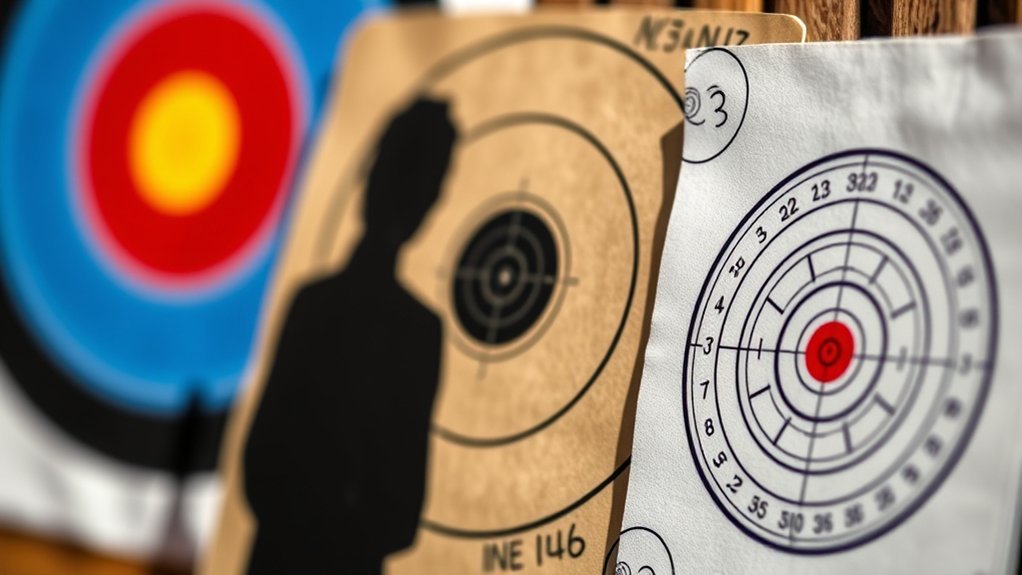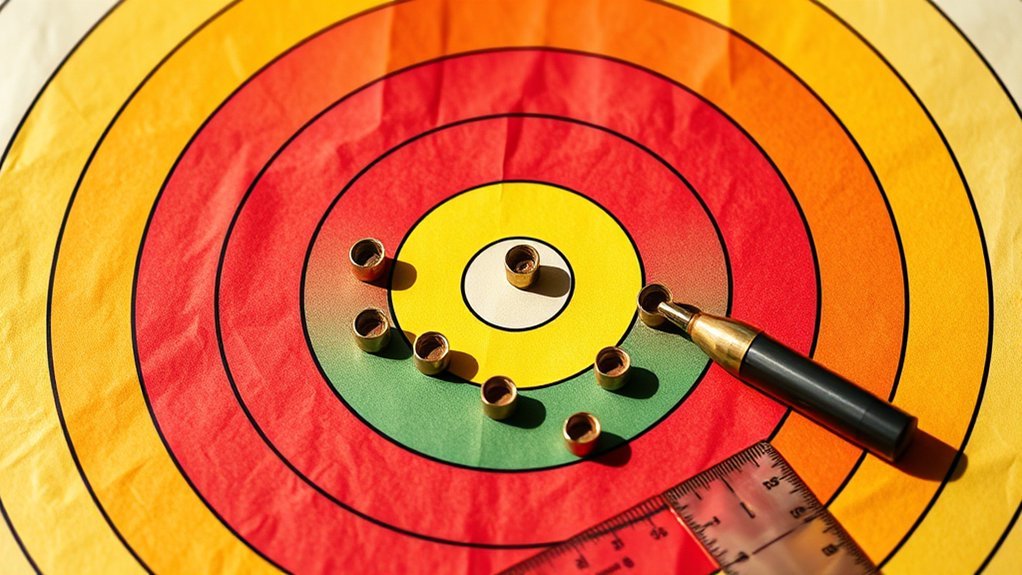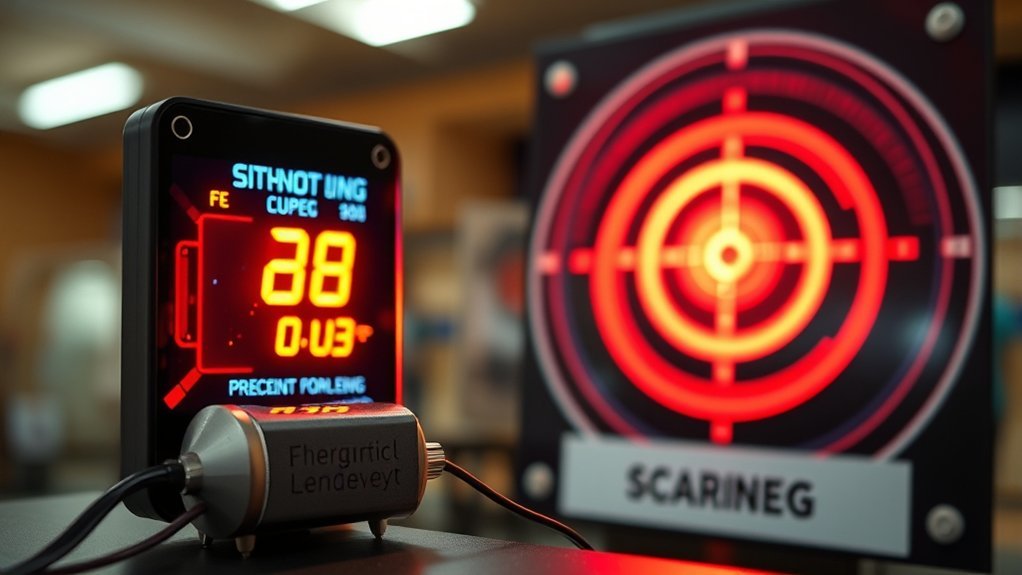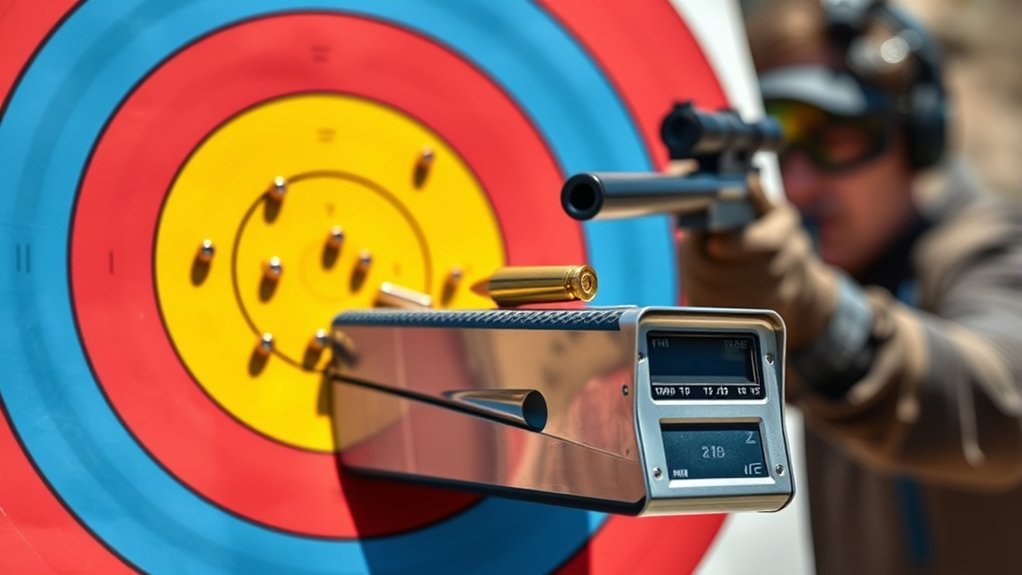Imagine you’re standing at the range, your heart racing as you aim for the bullseye on a traditional paper target. Understanding how scoring systems work can make or break your performance. From the intricacies of scoring rings to the impact of penalties, these elements play a vital role in your results. So, how do different scoring methods influence your strategy and outcomes in competitions? Let’s explore the various aspects of target shooting scoring systems.
Understanding Target Types

When you immerse yourself in target shooting, understanding the different types of targets is essential for honing your skills and improving your scores. Each target type serves a unique purpose, from traditional paper targets that provide clear scoring zones to reactive targets that offer instant feedback upon impact. You’ll encounter silhouettes, which help simulate real-life scenarios, and precision targets that challenge your accuracy at varying distances. Knowing these types allows you to tailor your practice sessions effectively. For example, using paper targets can sharpen your aim, while reactive targets boost your confidence as you see immediate results. By familiarizing yourself with each target, you’ll enhance your overall shooting proficiency and develop a more strategic approach to your training.
Traditional Paper Target Scoring

When it comes to traditional paper target scoring, understanding the scoring zones is essential for accurate point allocation. Each zone represents a different point value, and knowing how these work can greatly impact your overall score. Let’s break down the system to help you maximize your performance.
Scoring Zones Overview
Scoring zones on traditional paper targets serve as the foundation for evaluating a shooter’s accuracy and skill. Each target typically features concentric circles, with the center, known as the bullseye, representing the highest score. As you move outward, scoring zones decrease in value, reflecting the shooter’s precision. Understanding these zones is essential; they directly impact your performance and strategy. For instance, hitting the bullseye not only boosts your score but also enhances your confidence. Familiarizing yourself with these zones allows you to assess your strengths and weaknesses, guiding your practice sessions. Ultimately, mastering the scoring zones helps you develop a sharper focus and improve your overall shooting technique, making every shot count.
Point Allocation System
Understanding how points are allocated in traditional paper target scoring is essential for any shooter aiming to improve their game. Each shot you take earns points based on where it lands on the target. The closer you hit to the center, the higher your score.
Here’s a quick breakdown of the point allocation system:
| Zone | Points | Description |
|---|---|---|
| Inner | 10 | Center bullseye hit |
| Outer | 9 | Immediate surrounding |
| Inner | 8 | Second ring |
| Outer | 7 | Third ring |
| Missed | 0 | Outside the target |
Electronic Scoring Systems

As technology continues to advance, electronic scoring systems have transformed the way target shooting events are conducted and scored. These systems use high-resolution cameras and sensors to automatically detect and score shots, providing instant feedback. You no longer have to rely on manual scoring, which can be prone to human error. With electronic systems, accuracy improves greatly, allowing for more precise competition outcomes. Furthermore, real-time data is displayed on screens, enhancing the spectator experience and keeping shooters informed. You’ll appreciate the efficiency these systems bring, as they streamline event administration and reduce the time spent on scoring. Overall, electronic scoring systems represent a major leap forward in ensuring fairness and accuracy in target shooting competitions.
Scoring Zones Explained
In target shooting, the concept of scoring zones plays an essential role in determining the outcome of competitions. Each target is divided into distinct areas, or zones, each assigned a specific score based on its proximity to the center. As you shoot, your goal is to hit these zones accurately, as they directly influence your overall score. Understanding these zones helps you strategize your shots, focusing on precision and technique. The closer you hit to the center, the higher your score will be, emphasizing the importance of control. Familiarizing yourself with the layout of scoring zones can enhance your performance, allowing you to maximize your scoring potential during competitions. So, practice targeting these zones to sharpen your skills and improve your accuracy.
Value of Each Scoring Ring
Each scoring zone has a specific value that plays a key role in your overall performance. Typically, the innermost ring, often called the bullseye, scores the highest—usually 10 points. As you move outward, the values decrease, often ranging from 9 to 1. Understanding these values is essential; aiming for the higher-scoring rings can greatly boost your total score. You’ll want to develop a strategy that prioritizes precision over speed, as hitting a higher value can make all the difference in a close competition. Furthermore, knowing the scoring system helps you gauge your progress and adjust your training focus. By mastering the value of each ring, you’ll enhance both your tactical approach and your shooting accuracy.
Time Limits and Scoring Implications
Time constraints can really influence your performance in target shooting. You might find that the pressure of a ticking clock alters your focus and decision-making, impacting your overall score. Understanding how to manage these time limits is essential for improving your shooting accuracy under stress.
Time Constraints Impact Performance
While competing in target shooting, the pressure of time constraints can greatly influence your performance and overall scoring. When the clock’s ticking, several factors come into play that can affect your results:
- Focus and Concentration: You may struggle to maintain focus, leading to mistakes in your shots.
- Decision-Making: Quick decisions on aiming and shooting can result in hasty choices that compromise accuracy.
- Breathing and Heart Rate: The urgency can elevate your heart rate, impacting your steadiness and control.
- Mental Fatigue: Constantly racing against time can drain your mental energy, reducing your overall effectiveness.
Understanding these impacts can help you develop strategies to manage time pressure, ultimately improving your performance and scoring potential.
Scoring Under Pressure
As you navigate the pressures of competition, understanding how scoring works under time constraints becomes essential. When you’re racing against the clock, every second counts, and your focus shifts between accuracy and speed. Typically, scoring systems incorporate both direct hits and timing, which means rushed shots can lead to lower scores. It’s vital to balance quick execution with precision; a well-placed shot often outweighs multiple hasty attempts. Be aware of the penalties for missed targets and how they can impact your overall score. Practicing under simulated time limits can help you find that sweet spot between speed and precision, ensuring you maximize your score even when the pressure’s on. Remember, mastering this balance sets successful shooters apart from the rest.
Scoring for Different Disciplines
Scoring systems in target shooting vary considerably across different disciplines, each designed to reflect the unique objectives and challenges of the sport. Understanding these differences can enhance your performance and strategy. Here are four key scoring systems you might encounter:
- Precision Shooting: Points are awarded based on accuracy with higher scores for shots closer to the center of the target.
- Speed Shooting: Scoring emphasizes the time taken to hit targets, rewarding both speed and accuracy.
- Field Target Shooting: This combines hunting scenarios and requires you to adjust for distance, angle, and environmental conditions.
- 3-Gun Competition: Scoring evaluates your performance across three different firearms, emphasizing versatility and adaptability.
Each scoring system encourages distinct skills and strategies, shaping your approach to the discipline.
Impact of Penalties on Scores
When you’re competing in target shooting, penalties can greatly alter your final score. Understanding the different types of penalties and how they adjust your scoring is essential for maintaining a competitive edge. Not only do these penalties affect your individual score, but they can also impact your overall rankings within the sport.
Types of Penalties
While penalties in target shooting may seem like minor inconveniences, they can considerably impact your overall score. Understanding the types of penalties can help you avoid them and improve your performance. Here are four common penalties you might encounter:
- Equipment Violations: Using unauthorized gear can lead to disqualification or point deductions.
- Safety Infractions: Failing to follow safety protocols can result in severe penalties, including immediate disqualification.
- Time Violations: Not adhering to time limits can cost you valuable points or entire rounds.
- Improper Scoring: Misjudging your shot placement or incorrectly marking your score can lead to penalties that may affect your final tally.
Scoring Adjustments
Understanding how penalties impact your overall score is essential for any target shooter aiming for success. When you incur a penalty, it directly affects your score in various ways, often subtracting points or adding time to your performance. Each type of penalty has specific consequences, so knowing these can help you strategize effectively. For instance, hitting an unintended target might cost you more points than a simple procedural error. By staying aware of potential penalties, you can adjust your approach, ensuring you minimize mistakes. Always remember, every point counts in competitive shooting, and the difference between winning and losing can hinge on how well you manage your scoring adjustments related to penalties. Stay focused, and keep your score in check!
Impact on Rankings
The impact of penalties on your scores can greatly influence your rankings in competitive target shooting. Understanding how these penalties work is essential for maintaining your position in competitions. Here are some key factors to reflect on:
- Score Deduction: Penalties often involve subtracting points from your total, which can quickly drop your rank.
- Time Penalties: Delays in shooting or failure to follow time limits can lead to additional penalties, further affecting your overall score.
- Equipment Violations: Using non-compliant gear can result in disqualification or point deductions, impacting your rankings considerably.
- Behavioral Infractions: Unsportsmanlike conduct can lead to penalties that not only reduce scores but also tarnish your reputation in the sport.
Stay aware of these aspects to safeguard your rankings and improve your performance.
Record Keeping and Performance Tracking
Effective record keeping and performance tracking in target shooting can greatly enhance your skills and help you identify areas for improvement. By logging your scores, conditions, and techniques, you can analyze trends and make informed adjustments. Here’s a simple table to illustrate what to track:
| Date | Score | Notes |
|---|---|---|
| 2023-09-01 | 85 | Windy, adjusted stance |
| 2023-09-08 | 90 | No wind, focused on breathing |
| 2023-09-15 | 88 | Tired, need more rest |
| 2023-09-22 | 92 | New grip technique successful |
Using this data, you can pinpoint what works best for you and refine your approach for improved performance. Consistent tracking empowers you to reach your shooting goals more effectively.
Tips for Improving Scoring Accuracy
To boost your scoring accuracy in target shooting, focus on refining your technique and mental approach. Here are four essential tips to enhance your performance:
- Establish a Consistent Stance: Verify your feet are shoulder-width apart and your body is balanced, providing a stable foundation for each shot.
- Practice Controlled Breathing: Develop a breathing rhythm to help steady your aim. Inhale deeply, exhale lightly, and pull the trigger during your natural pause.
- Focus on the Trigger Pull: Use a smooth, slow trigger pull to prevent jerking the gun, which can throw off your accuracy.
- Visualize Success: Before each shot, visualize hitting your target. This mental rehearsal can enhance your confidence and focus during practice and competition.
Conclusion
In target shooting, mastering the scoring system is like fine-tuning a musical instrument; every detail matters for a harmonious performance. By understanding different target types, scoring zones, and the impact of penalties, you can elevate your game and sharpen your focus. Keep track of your progress and embrace the challenge of improvement, as each shot taken is a step closer to your goals. With practice and strategy, you’ll hit the bullseye of success in no time.


1 thought on “Target Shooting Scoring Systems Explained”